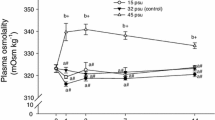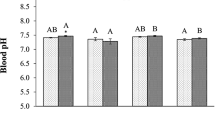Abstract
In previous studies in freshwater tilapia (Oreochromis mossambicus), dietary supplementation with arachidonic acid (ArA; 20:4n − 6) had considerable, opposing effects on the main ion-transporting enzyme Na+/K+-ATPase in gills and kidneys and changed the release of osmoregulatory hormones, such as cortisol. The present study was performed to assess the influence of dietary ArA on (1) the osmoregulatory capacity of tilapia acclimated to seawater (SW) (34‰) and (2) the osmoregulatory imbalance associated with acute stress. The increased ambient salinity was associated with significant alterations in the tissue fatty acid composition, particularly the n − 6 polyunsaturated fatty acids (PUFAs). Tissue levels of ArA were further increased as a result of dietary supplementation, whereas docosahexaenoic acid (DHA, 22:6n − 3) and eicosapentaenoic acid (EPA, 20:5n − 3) decreased in gills and kidneys. Basal plasma cortisol as well as lactate levels were elevated in the ArA-supplemented SW-acclimated tilapia compared with the control group. The 5 min of confinement (transient stress) increased plasma cortisol, glucose, and lactate levels with significantly higher levels in ArA-supplemented tilapia. Confinement was also associated with significantly elevated plasma osmolality, sodium, chloride, and potassium levels. ArA-supplemented tilapia showed markedly lower ionic disturbances after confinement, suggesting that dietary ArA can attenuate the hydromineral imbalance associated with acute stress. These results emphasize the involvement of ArA and/or its metabolites in the endocrine and osmoregulatory processes and the response to confinement stress.





Similar content being viewed by others
References
Assem H, Hanke W (1981) Cortisol and osmotic adjustment of the euryhaline teleost, Sarotherodon mossambicus. Gen Comp Endocrinol 43:370–380
Axelrod J, Burch A, Jelsema CL (1988) Receptor-mediated activation of phospholipase A2 via GTP-binding proteins: arachidonic acid and its metabolites as second messengers. Trends Neurosci 11:117–123
Bandyopadhyay GK, Dutta J, Ghosh S (1982) Synthesis of diene prostaglandins in freshwater fish. Lipids 17:755–758
Barton BA, Iwama GK (1991) Physiological changes in fish from stress in aquaculture with emphasis on the stress response and effects of corticosteroids. Annu Rev Fish Dis 1:3–26
Beckman B, Mustafa T (1992) Arachidonic acid metabolism in gill homogenate and isolated gill cells from rainbow trout, Oncorhynchus mykiss: the effect of osmolality, electrolytes and prolactin. Fish Physiol Biochem 10:213–222
Bell JG, Tocher DR, Farndale BM, Cox DI, McKinney RW, Sargent JR (1997) The effect of dietary lipid on polyunsaturated fatty acid metabolism in Atlantic Salmon (Salmo salar) undergoing parr-smolt transformation. Lipids 32:515–525
Breves JP, Hirano T, Grau G (2010) Ionoregulatory and endocrine responses to disturbed salt and water balance in Mozambique tilapia exposed to confinement and handling stress. Comp Biochem Physiol 155A:294–300
Brown JA, Gray CJ, Hattersley G, Robinson J (1991) Prostaglandins in the kidney, urinary bladder and gills of the rainbow trout and European eel acclimated to fresh water and seawater. Gen Comp Endocrinol 84:329–335
Curnow RT, Nuttal FQ (1972) Effect of prostaglandin E administration on the liver glycogen synthase and phosphorylase systems. J Biol Chem 247:1892–1898
Dange AD (1985) Branchial Na+-K+-ATPase activity during osmotic adjustments in two freshwater euryhaline teleosts, tilapia (Sarotherodon mossambicus) and orange chromid (Etroplus maculatus). Mar Biol 87:101–107
De Silva SS, Gunasekera RM, Austin CM (1997) Changes in the fatty acid profiles of hybrid red tilapia, Oreochromis mossambicus X O. niloticus, subjected to short-term starvation, and a comparison with changes in seawater raised fish. Aquaculture 153:273–290
Dean DB, Whitlow ZW, Borksi RJ (2003) Glucocorticoid receptor upregulation during seawater adaptation in a euryhaline teleost, the tilapia (Oreochromis mossambicus). Gen Comp Endocrinol 132:112–118
Dharmamba M, Bornancin M, Maetz J (1975) Environmental salinity and sodium and chloride exchanges across the gill of Tilapia mossambica. J Physiol (Paris) 70:627–636
Gupta OP, Lahlou B, Botella J, Porthé-Nibelle J (1985) In vivo and in vitro studies on the release of cortisol from interrenal tissue in trout. I. Effects of ACTH and prostaglandins. Exp Biol 43:201–212
Harel M, Gavasso S, Leshin J, Gubernatis A, Place AR (2001) The effect of tissue docosahexaenoic and arachidonic acids levels on hypersaline tolerance and leucocyte composition in striped bass (Morone saxatilis) larvae. Fish Physiol Biochem 24:113–123
Hegab SA, Hanke W (1984) The significance of cortisol for osmoregulation in carp (Cyprinus carpio) and tilapia (Sarotherodon mossambicus). Gen Comp Endocrinol 54:409–417
Henderson RJ, Sargent JR (1985) Chain-length specificities of mitochondrial and peroxisomal β-oxidation of fatty acids in livers of rainbow trout (Salmo gairdneri). Comp Biochem Physiol 82B:79–85
Hwang PP, Sun CM, Wu SM (1989) Changes of plasma osmolality, chloride concentration and gill Na+, K+-ATPase activity in tilapia Orechromis mossambicus during seawater acclimation. Mar Biol 100:295–299
Kallen CB, Arakane F, Christenson LK, Watari H, Devoto L, Straus JF III (1998) Unveiling the mechanism of action and regulation of the steroidogenic acute regulatory protein. Mol Cell Endocrinol 145:39–45
Koven WM, Barr Y, Lutzky S, Ben Atia I, Weiss R, Harel M, Behrens P, Tandler A (2001) The effect of dietary arachidonic acid (20:4n–6) on growth, survival and resistance to handling stress in gilthead seabream (Sparus aurata) larvae. Aquaculture 193:107–122
Koven WM, Van Anholt RD, Lutzky S, Ben Atia I, Nixon O, Ron B, Tandler A (2003) The effect of dietary arachidonic acid on growth, survival, and cortisol levels in different-age gilthead seabream larvae (Sparus aurata) exposed to handling or daily salinity change. Aquaculture 228:307–320
Lacroix M, Hontela A (2001) Regulation of acute cortisol synthesis by cAMP-dependent protein kinase A and protein kinase C in a teleost species, the rainbow trout (Oncorhynchus mykiss). J Endocrinol 169:71–78
Lang CH, Blakesley HL, Bagby GJ, Spitzer JJ (1988) Lipoxygenase and cyclooxygenase blockade by BW755C prevents endotoxin-induced hypotension but not changes in glucose metabolism. Horm Metab Res 20:551–554
McCormick SD (1995) Hormonal control of gill Na+, K+-ATPase and chloride cell function. In: Wood CM, Shuttelworth TJ (eds) Fish physiology, XIV cellular and molecular approaches to fish ionic regulation. Academic Press, San Diego, pp 285–315
McCormick SD (2001) Endocrine control of osmoregulation in teleost fish. Am Zoo 41:781–794
Morgan JD, Sakamoto T, Grau EG, Iwama GK (1997) Physiological and respiratory responses of the Mozambique tilapia (Oreochromis mossambicus) to salinity acclimation. Comp Biochem Physiol 117A:391–398
Mustafa T, Srivastava KC (1989) Prostaglandins (eicosanoids) and their role in ectothermic organisms. Adv Comp Environ Physiol 5:157–207
Naor Z (1991) Is arachidonic acid a second messenger in signal transduction? Mol Cell Endocrinol 80:C181–C186
Nolan DT, Op’t Veld RLJM, Balm PHM, Wendelaar Bonga SE (1999) Ambient salinity modulates the response of the tilapia, Oreochromis mossambicus (Peters), to net confinement. Aquaculture 177:297–309
Olsen RE, Henderson RJ, McAndrew BJ (1990) The conversion of linoleic acid and linolenic acid to longer chain polyunsaturated fatty acids by Tilapia (Oreochromis) nilotica in vivo. Fish Physiol Biochem 8:261–270
Prunet P, Bornancin M (1989) Physiology of salinity tolerance in tilapia: an update of basic and applied aspects. Aquat Living Resour 2:91–97
Sacca R, Perez G, Rengo F, Condorelli M (1974) Effects of different prostaglandins on glucose kinetics in the rat. Diabetes 23:532–534
Shrimpton JM, McCormick SD (1998) Seasonal differences in plasma cortisol and gill corticosteroid receptors in upper and lower mode juvenile Atlantic salmon. Aquaculture 168:205–219
Skalski M, Goto M, Ravindranath T, Myers T, Zeller WP (2001) Omega-3 polyunsaturated fatty acid enriched diet attenuates stress-induced lactacidemia in 10-day-old rats. Pediatrics Int 43:409–416
Swann AC (1984) Free fatty acids and (Na+, K+)-ATPase: effects on cation regulation, enzyme conformation, and interactions with ethanol. Arch Biochem Biophys 233:354–361
Swarts HGP, Schuurmans-Steckhoven FMAH, De Pont JJHHM (1990) Binding of unsaturated fatty acids to Na+, K+-ATPase leading to inhibition and inactivation. Biochim Biophys Acta 1024:32–40
Tocher DR, Bell JG, Dick JR, Henderson RJ, McGhee F, Michell D, Morris PC (2000) Polyunsaturated fatty acid metabolism in Atlantic salmon (Salmo salar) undergoing parr-smolt transformation and the effects of dietary linseed and rapeseed oils. Fish Physiol Biochem 23:59–73
Tocher DR, Agaba M, Hastings N, Bell JG, Dick JR, Teale AJ (2002) Nutritional regulation of hepatocyte fatty acid desaturation and polyunsaturated fatty acid composition in zebrafish (Danio rerio) and tilapia (Oreochromis niloticus). Fish Physiol Biochem 24:309–320
Van Anholt RD, Spanings T, Koven WM, Wendelaar Bonga SE (2003) Effects of acetylsalicylic acid on thyroid hormones, prolactins, and the stress response of tilapia (Oreochromis mossambicus). Amer J Physiol Regul Integr Comp Physiol 285:R1098–R1106
Van Anholt RD, Spanings T, Koven WM, Wendelaar Bonga SE (2004a) Dietary supplementation with arachidonic acid in tilapia (Oreochromis mossambicus) reveals physiological effects not mediated by prostaglandins. Gen Comp Endocrinol 139:215–226
Van Anholt RD, Spanings FA, Koven WM, Nixon O, Wendelaar Bonga SE (2004b) Arachidonic acid reduces the stress response of gilthead sea bream Sparus aurata L. J Exper Biol 207:3419–3430
Vijayan MM, Pereira C, Grau EG, Iwama GK (1997) Metabolic responses associated with confinement stress in tilapia: the role of cortisol. Comp Biochem Physiol 116C:89–95
Wendelaar Bonga SE (1997) The stress response in fish. Physiol Rev 77:591–625
Yokotani K, Murakami Y, Okada S, Hirata M (2001) Role of brain arachidonic acid cascade on central CRF1 receptor mediated activation of sympatho-adrenomedullary outflow in rats. Eur J Pharm 419:183–189
Acknowledgments
The authors thank Dr. G. Kissil (IOLR-NCM, Eilat, Israel) for providing the specially prepared pellets and the Department of Epidemiology and Biostatistics (Nijmegen University Hospital St. Radboud) for their advice on the statistical analyses.
Author information
Authors and Affiliations
Corresponding author
Rights and permissions
About this article
Cite this article
Van Anholt, R.D., Spanings, F.A.T., Nixon, O. et al. The effects of arachidonic acid on the endocrine and osmoregulatory response of tilapia (Oreochromis mossambicus) acclimated to seawater and subjected to confinement stress. Fish Physiol Biochem 38, 703–713 (2012). https://doi.org/10.1007/s10695-011-9552-6
Received:
Accepted:
Published:
Issue Date:
DOI: https://doi.org/10.1007/s10695-011-9552-6




